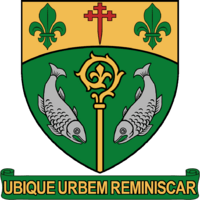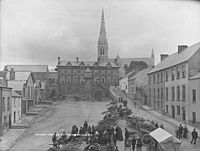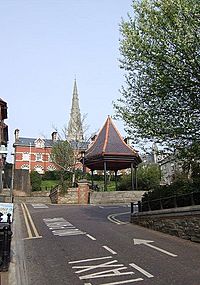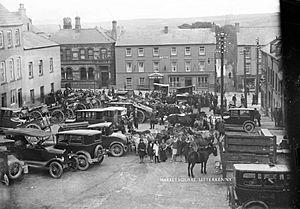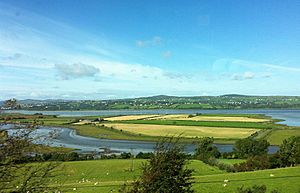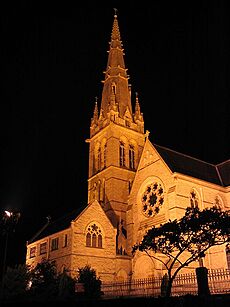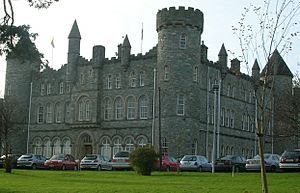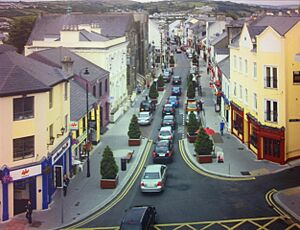Letterkenny facts for kids
Quick facts for kids
Letterkenny
Leitir Ceanainn
|
||
|---|---|---|
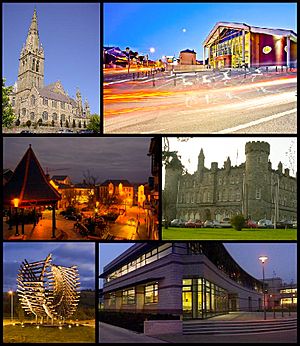
From top, left to right: St Eunan's Cathedral, An Grianán Theatre, the Market Square, St Eunan's College, Polestar Roundabout (also known as the Port Roundabout), Letterkenny Institute of Technology.
|
||
|
||
| Nickname(s):
the Cathedral Town
|
||
| Motto(s):
Ubique Urbem Reminiscar
"Remember the town wherever I am" |
||
| Country | Ireland | |
| Province | Ulster | |
| County | County Donegal | |
| Baronies | Kilmacrenan and Raphoe North | |
| Dáil constituency | Donegal | |
| Area | ||
| • Total | 15.5 km2 (6.0 sq mi) | |
| Elevation | 52 m (171 ft) | |
| Population
(2022 census)
|
||
| • Total | 22,549 | |
| • Density | 1,455/km2 (3,768/sq mi) | |
| Irish Grid Reference | C171121 | |
| Dialing code | 074 91// 0035374 | |
Letterkenny (Irish: Leitir Ceanainn), also known as the Cathedral Town, is a large town in County Donegal, Ireland. It sits on the River Swilly in the northwest part of Ulster. Letterkenny and the nearby city of Derry are important economic hubs for this region of Ireland.
Letterkenny started as a market town in the early 1600s during a time called the Plantation of Ulster. A castle once stood near where the Cathedral of St Eunan and St Columba is today. This cathedral is County Donegal's only Catholic cathedral. The town is home to Atlantic Technological University (ATU) Letterkenny, St Eunan's College, Highland Radio, and a Hindu temple. Letterkenny was also where the Oatfield Sweet Factory used to be, but it closed in 2014. In 1798, a famous Irish rebel named Theobald Wolfe Tone was arrested in a hotel here. In 2015, Letterkenny was named the tidiest town in Ireland!
Contents
What's in a Name?
The name Letterkenny comes from the Irish Leitirceanainn. This means "Hillside of the O'Cannons." The O'Cannons were the last ancient chiefs of Tír Conaill, which is now County Donegal. Even though there are no old forts or castles of the O'Cannon clan in Letterkenny itself, a place called Doon Rock, about eight miles west, is thought to be where the O'Cannon Kings used to be crowned.
The O'Cannon family line comes from very old Irish kings like Conn of the Hundred Battles and Niall of the Nine Hostages. They were known as 'Ancient Princes' and 'Valiant Chiefs'. Their rule in Tír Conaill ended in 1250. The name Canannain means 'wolf cub'. Over time, the name was changed to O'Cannon and then simply Cannon.
A Look Back in Time
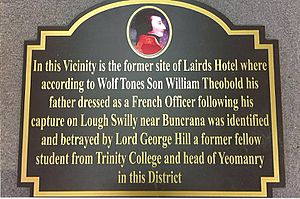
Letterkenny started as a market town in the early 1600s. This was during the Plantation of Ulster, when many Scottish and English settlers came to Ireland. It might have been built on the site of an even older Irish settlement. Letterkenny was the first place where people could cross the River Swilly.
Long ago, Letterkenny was mostly a farming town. There were lots of cattle and sheep grazing on the hillsides. The sea used to come much further inland, almost to New Mills. This is why there are flat lands between the Oldtown and the Port Road today.
Rory O'Cannon, the last chief of his clan, died in 1248. Another leader, Godfrey O'Donnell, became King of Tír Conaill. He fought a Norman lord in 1257 and was badly hurt. Even though he was dying, Godfrey led his forces to defeat another enemy, O'Neill, by the River Swilly in 1258. Godfrey died after the battle near where Letterkenny is now and was buried in Conwal Cemetery.
As the sea moved back, it became easier to build bridges. This helped Letterkenny grow into the town we see today. Around 1609, a Scottish man named Patrick Crawford was given a large area of land. He started the markets, which grew from just a few animals to very busy trading spots.
An old castle, built in 1625, once stood near where the Cathedral of St Eunan and St Columba is now. Sadly, no parts of it remain today.
During the Irish Rebellion of 1798, a large French force, including the rebel leader Wolfe Tone, tried to land in County Donegal. They were stopped by the British navy. Wolfe Tone was captured and held for a short time at Laird's Hotel in Letterkenny before being moved to Derry Gaol. He later died in prison.
In 1824, people described Letterkenny as a modern town. Ships of 100 tons would bring goods like iron and salt to the Port of Ballyraine and take away hides and butter. Today, only the old warehouses remain.
Letterkenny officially became a town in the early 1920s after Ireland was divided. When the Irish punt replaced the British pound sterling in County Donegal in 1928, many Irish banks that were in Derry (which was now in Northern Ireland) opened new branches in Letterkenny.
Where is Letterkenny?
Weather in Letterkenny
The weather in Letterkenny is measured at Malin Head, which is the very northern tip of the county. Letterkenny has a mild oceanic climate. This means it's not too hot and not too cold, thanks to being near the Atlantic Ocean and the warm Gulf Stream.
Because it's quite far north, Letterkenny has long days in summer and short days in winter. Summers are cool, with temperatures rarely going above 25°C. Winters are mild, with daytime temperatures usually staying above 0°C. It rarely gets extremely hot, but sometimes very cold air from the Arctic can cause temperatures to drop below 0°C. Snow isn't very common, usually falling about 20 days a year, mostly from December to March. It rains quite a lot throughout the year, with more rainy days in winter.
| Climate data for Letterkenny, Donegal (1981–2010) | |||||||||||||
|---|---|---|---|---|---|---|---|---|---|---|---|---|---|
| Month | Jan | Feb | Mar | Apr | May | Jun | Jul | Aug | Sep | Oct | Nov | Dec | Year |
| Mean daily maximum °C (°F) | 8 (46) |
8 (46) |
10 (50) |
12 (54) |
14 (57) |
16 (61) |
17 (63) |
18 (64) |
16 (61) |
13 (55) |
10 (50) |
8 (46) |
12.2 (54.0) |
| Mean daily minimum °C (°F) | 4 (39) |
3 (37) |
4 (39) |
6 (43) |
8 (46) |
10 (50) |
12 (54) |
12 (54) |
11 (52) |
9 (48) |
6 (43) |
4 (39) |
7.5 (45.5) |
| Average precipitation mm (inches) | 117.4 (4.62) |
84.8 (3.34) |
85.9 (3.38) |
63.1 (2.48) |
56.9 (2.24) |
69.1 (2.72) |
76.8 (3.02) |
93.2 (3.67) |
91.8 (3.61) |
118.4 (4.66) |
104.5 (4.11) |
114.2 (4.50) |
1,076.1 (42.35) |
| Average precipitation days | 18 | 13 | 15 | 12 | 11 | 11 | 14 | 14 | 14 | 17 | 17 | 16 | 172 |
| Average snowy days | 5.1 | 5.2 | 3.4 | 1.6 | 0.1 | 0 | 0 | 0 | 0 | 0 | 1.1 | 3.8 | 20.3 |
| Mean monthly sunshine hours | 38.2 | 65.0 | 94.1 | 152.9 | 201.5 | 166.0 | 142.7 | 140.1 | 112.2 | 80.6 | 44.3 | 34.1 | 1,271.7 |
| Source 1: ECA&D | |||||||||||||
| Source 2: Met Éireann | |||||||||||||
Buildings and Design
Many of Letterkenny's important buildings were built in the early 1850s or even earlier. These include schools and churches. The tallest building in town is the Cathedral of St Eunan and St Columba, finished in 1901. It was designed in a style similar to French Gothic churches from the 1200s. Across from the cathedral is Conwal Parish Church, with parts dating back to the 1600s.
Another well-known building is St Eunan's College. It's a three-story building with a castle-like look, built in 1904. It has four round towers and flying buttresses, which are like the ones on the nearby cathedral.
You can also find interesting buildings at Mount Southwell Terrace. This row of five red brick houses was built in 1837. The Donegal County Museum is in the old workhouse building on High Road, which was finished in 1843.
In more recent times, Letterkenny has added modern buildings. The new Letterkenny Town Council offices, sometimes called "The Grasshouse," have a unique sloping grass roof.
Who Lives in Letterkenny?
| Historical population | ||
|---|---|---|
| Year | Pop. | ±% p.a. |
| 1911 | 3,691 | — |
| 1926 | 3,631 | −0.11% |
| 1936 | 4,080 | +1.17% |
| 1946 | 4,410 | +0.78% |
| 1951 | 4,622 | +0.94% |
| 1956 | 4,561 | −0.27% |
| 1961 | 4,679 | +0.51% |
| 1966 | 4,967 | +1.20% |
| 1971 | 5,568 | +2.31% |
| 1979 | 7,537 | +3.86% |
| 1986 | 9,864 | +3.92% |
| 1991 | 10,726 | +1.69% |
| 1996 | 11,996 | +2.26% |
| 2002 | 15,231 | +4.06% |
| 2006 | 17,586 | +3.66% |
| 2011 | 19,588 | +2.18% |
| 2016 | 19,274 | −0.32% |
| 2022 | 22,549 | +2.65% |
| Source: CSO | ||
Letterkenny is the biggest town in County Donegal. For a long time, many people left Ireland to live elsewhere. But since the 1990s, more people have been moving into Letterkenny. These new residents come from places like Central Europe, Africa, and Asia. This is why you can find many different kinds of restaurants and shops in town, including Chinese, Indian, and stores that sell goods for people from various countries. Letterkenny even has one of Ireland's few Hindu temples.
In 2006, about 16% of Letterkenny's population were from other countries. This shows that many of Donegal's international residents live in Letterkenny.
Learning in Letterkenny
Letterkenny has several schools for different age groups. There are 5 primary schools and 4 secondary schools.
One of the most well-known secondary schools is St Eunan's College. It's named after Adomnán or Eunan, a saint who was from County Donegal.
Coláiste Ailigh is a special secondary school where all the lessons are taught through the Irish language. The Loreto Convent Secondary School, near the cathedral, has been open for over 150 years.
For higher education, there's ATU Donegal Letterkenny (formerly Letterkenny Institute of Technology). It's a place where students can study subjects like engineering, information technology, design, business, and nursing.
Working in Letterkenny
The Letterkenny Chamber of Commerce and Industry helps local businesses. It was started in 1965 and works to support the town's economy.
Shopping in Letterkenny
Letterkenny has a mix of modern shopping centres and smaller, family-owned shops that sometimes sell handmade items. It's a major shopping hub for the northwest region, serving people from County Donegal and Derry.
The three main shopping malls are the Courtyard Shopping Centre, the Letterkenny Retail Park, and the Letterkenny Shopping Centre. The Letterkenny Shopping Centre is the oldest, built in 1984, and is the largest in County Donegal. It has grown a lot since it first opened. These centres have many well-known international and Irish stores like Tesco and Penney's. There are also smaller shopping areas like the Glencar Shopping Centre.
In the past, Letterkenny's Main Street was the main shopping area. While trade has spread out, Main Street still has older shops like R. McCullagh Jewellers (since 1869) and Magees Pharmacy (since 1928). Newer businesses have also opened on streets like Church Street and Castle Street.
Jobs and Businesses
Letterkenny is an important centre for jobs in the northwest of Ireland. Some of the biggest employers include Letterkenny University Hospital, Pramerica, Optum Health Care, and the Department of Social and Family Affairs.
Pramerica started in Letterkenny in 2000 and grew to have over 2,000 employees. It was taken over by Tata Consultancy Services in 2020, but some Prudential staff still work there.
While there are fewer manufacturing jobs now, more people work in the service sector. Since 2002, the retail sector has grown a lot. The town has also developed its cultural side, with places like An Grianán Theatre and a new arts centre opening.
The town's economy is also affected by trade with Northern Ireland, especially by the exchange rate between the Euro and the British Pound.
News and Radio
Letterkenny has access to all national TV channels. Because it's close to Derry City and Strabane in Northern Ireland, people can also receive TV signals from there.
The local radio station is Highland Radio, which started broadcasting in 1990.
Several newspapers are based in Letterkenny. The main regional newspaper is the Donegal Democrat. Other local papers include the Derry People/Donegal News and the Tirconaill Tribune. There are also free newspapers like the Letterkenny People and the Letterkenny Post. The Derry Journal is also popular in the area.
Fun in Letterkenny
Stories and Books
A niece of the famous writer Jane Austen is buried in Letterkenny, along with her husband Lord George Hill. Two other nieces of Jane Austen are buried just outside the town.
Things to Do
Every year, Letterkenny hosts fun events like the Saint Patrick's Day Parade in March and the Earagail Arts Festival in June/July.
An Grianán Theatre is the biggest theatre in County Donegal, with seats for 383 people. It hosts many live shows. The Letterkenny Regional Cultural Centre opened in 2007 and is located behind the theatre.
Letterkenny has hosted the annual Irish traditional music festival, the Fleadh Cheoil, in 2005 and 2006. It also hosted the international Pan Celtic Festival in 2006 and 2007. This festival brings together Celts from Ireland, Wales, Scotland, the Isle of Man, Brittany, and Cornwall for music, dance, and fun.
For movies, there's Century Cinemas, an eight-screen cinema complex.
Letterkenny is a popular place for nightlife, especially on weekends, with many pubs and nightclubs on the Main Street.
The town is also the namesake of a fictional town in the Canadian TV show Letterkenny.
Famous People
Sports and Activities
Letterkenny has a modern sports complex with a swimming pool, football pitches, and sports halls. The most popular sports are Gaelic football, rugby, and soccer. Other sports like hurling, boxing, golf, swimming, and gymnastics are also played.
Soccer
Letterkenny Rovers F.C. plays its home games at Leckview Park. Bonagee United and Glencar Celtic F.C. are other local teams. There are also many soccer clubs for school children. The closest professional football club is Finn Harps in Ballybofey, about 12 miles away.
Some famous footballers like Paul Scholes and Rory Delap have connections to Letterkenny and often visit.
Gaelic Football
Letterkenny has two Gaelic games clubs: St Eunan's and Letterkenny Gaels. St Eunan's is one of Donegal's most successful clubs. Letterkenny Gaels was formed in 1996 and offers football, ladies' football, hurling, and other activities.
Rugby
Rugby is played at different levels in Letterkenny. Letterkenny RFC was founded in 1973. The club has special ties with New Zealand rugby because Dave Gallaher, the first captain of the All Blacks, was born nearby. The club's rugby ground is named the Dave Gallaher Memorial Park in his honour.
Other Sports
Letterkenny has two men's basketball teams and a junior basketball club. Letterkenny Golf Club is just outside the town centre. There are also pitch and putt and tennis facilities. The Letterkenny Sports Complex has a skate park. Letterkenny Athletic Club is also in town.
Letterkenny hosts the Donegal International Rally every June and the Donegal Harvest Rally every October. The Donegal Marathon was restarted in 2014 after 30 years. Other annual events include the North West 10K and the Gartan Triathlon.
Getting Around Letterkenny
By Air
The closest airport is City of Derry Airport, about 48 km (30 miles) to the east. Donegal Airport (also called Carrickfinn Airport) is less than an hour away to the west. The closest major international airport is Belfast International Airport in County Antrim.
Letterkenny has a small private airfield for light aircraft. There's also another small private airfield nearby at Finn Valley.
By Train
In the past, Letterkenny was connected to a large narrow-gauge railway network in County Donegal. These trains connected the town to Derry, Lifford, Strabane, Gweedore, Burtonport, and Carndonagh. These railway lines were built in the late 1800s and early 1900s. However, after Ireland became independent, the railway companies had to operate across two countries, which made things difficult. All the train lines in the area closed by December 1959.
Today, the closest train station is Derry~Londonderry railway station in Derry. This station is run by NI Railways and connects to Belfast Lanyon Place railway station and Belfast Grand Central station. There are plans to improve the train line between Belfast and Derry.
In 2023, a report suggested building a new train line between Derry and Letterkenny. This would allow for direct train services from Letterkenny to Dublin and Belfast. This project might happen between 2030 and 2050.
By Bus
Bus Éireann runs many daily bus services from Letterkenny bus station to larger cities in Ireland like Dublin, Derry, and Galway. Other private bus companies also offer daily services. The Lough Swilly Bus Company used to run local services but stopped in 2014. Bus Éireann is now the main bus service in town.
Letterkenny is also connected to other parts of County Donegal by TFI Local Link routes. Private companies also provide daily bus services to Derry and Belfast.
By Road
Two main national roads serve Letterkenny: the N13 from the South and the N14 from the East. The N13 also connects to the A2 road to Derry. The N56 secondary road starts in Letterkenny and goes around the county, ending in Donegal town. Other local roads connect Letterkenny to areas like Fanad, Rosguill, Glenties, and Churchill.
By Taxi
You can find taxi services at a taxi stand on Main Street at Market Square.
Keeping Letterkenny Clean
Letterkenny has a long history in Ireland's national Tidy Towns competition, which started in 1959. The town achieved its best result in 2015.
In 2007, Letterkenny was named "Best Kept Urban Centre" and won the top prize in the "Large Urban Centre" category at the Tidy Towns competition. It continued to do well, receiving a gold medal for nine years in a row. In 2012, it was chosen as the tidiest town in the northwest. In 2013, it was named one of Ireland's top ten towns.
In 2015, Letterkenny won the overall award as Ireland's tidiest town! It received the same high score in 2016, but it wasn't enough to keep the title that year.
Air Quality
In late 2019 and early 2020, the Environmental Protection Agency (EPA) reported that Letterkenny had high levels of air pollution. This was a concern for residents and was much higher than recommended limits set by the World Health Organisation.
Water Quality
Water quality has been a problem in Letterkenny. Some residents have reported their tap water being blue or smelling strongly of chlorine.
The European Commission has noted that Ireland has had issues with high levels of Trihalomethane (THM) in its water since 2003. High levels of THM can cause health problems. The highest levels of THM were found in County Donegal (where Letterkenny is), as well as in Counties Cork, Kerry, and Wicklow.
Sister Cities
Letterkenny is twinned with these places:
- Elizabethtown, Pennsylvania, United States
- Rudolstadt, Germany
- Wieluń, Poland
Letterkenny also has a "friendship agreement" with West Dunbartonshire Council in Scotland.
Images for kids
See also
 In Spanish: Letterkenny para niños
In Spanish: Letterkenny para niños


